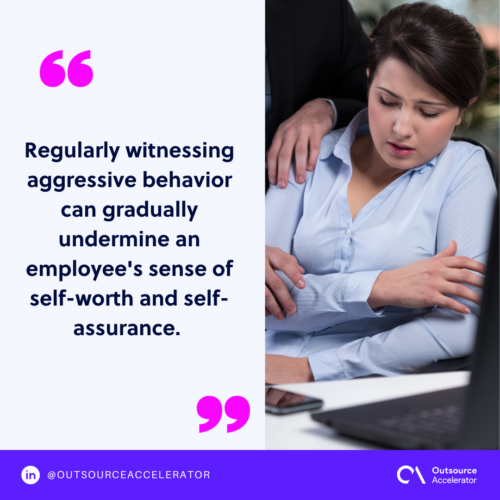Understanding and addressing aggressive communication in the workplace

Good communication style is essential for successful teamwork. Still, it can get complicated, leading to aggressive communication that harms professional relationships and employee well-being.
In this article, we’ll help you gain a deeper understanding of aggressive communication in the workplace, how to identify it, its causes, and its impact on employees.
We’ll also explore how leaders can promote respect and healthy relationships within their organizations.
Defining aggressive communication in the workplace
Aggressive communication in the workplace involves spoken or unspoken actions meant to intimidate, demean, hurt, and inflict negative emotions on others.
Aggression in the organization also encompasses off-putting communication patterns that can create physical violence, damaged relationships, and, ultimately, an unhealthy work environment.

Recognizing passive aggressive communication in the workplace
The first step in dealing with aggressive communicators is to spot the obvious and subtle signs affecting your work environment.
The table below shows the signs and examples of aggressive communication in the workplace.
| Signs | Example | |
| Raised voice and yelling | Speaking very loudly or shouting during conversations. | “I can’t believe you messed up that report again! How many times do I have to tell you?” |
| Name-calling and insults | Using mean words or calling someone names. | “You’re such an idiot for not understanding this simple concept.” |
| Blame-shifting | Not taking responsibility and always blaming others. | “This project failed because of your incompetence, not mine.” |
| Threats and intimidation | Trying to make someone scared or threatened to get what you want. | “If you don’t do what I say, you’ll regret it.” |
| Sarcasm and mockery | Making fun of someone in a hurtful way. | “Oh, great job on that presentation. You should be a stand-up comedian.” |
| Interrupting and talking over others | Not letting others speak, cutting them off. | “Let me finish. You don’t know what you’re talking about.” |
| Passive-aggressive behavior | Being mean indirectly through sneaky comments or actions. | “Oh, I’m sure your way is the best. We should all do it your way.” |
| Excessive criticism | Always finding faults in what others do without being helpful. | “Your performance is always subpar. You can never meet our standards.” |
| Ignoring and ostracizing | Leaving someone out on purpose to hurt them. | “Your performance is always subpar. You can never meet our standards.” |
| Defensive communication | Getting upset and defensive when someone gives you feedback. | “Why are you always picking on me? You’re just trying to make me look bad.” |
| Invasion of personal space | Standing too close to someone to make them uncomfortable. | Standing too close to a colleague while arguing. |
| Excessive swearing or inappropriate language | Using bad words or offensive language during conversations. | Cursing and using offensive language when frustrated. |
Root causes of aggressive communication style in the workplace
Understanding the root causes behind aggressive communication habits is essential to address the issue within the workplace and promote healthy boundaries.
Stress and pressure
An aggressive communicator often goes through intense stress and pressure. Verbal aggression is sometimes their way to cope or assert control.
Organizations must foster a supportive work environment that assists employees in handling stress and negative feelings effectively.
Lack of communication skills
Effective communication can be challenging for some individuals, especially when dealing with difficult conversations. Sometimes, they resort to aggressive tactics to convey their message and dominate conversations.
Offering communication training can help foster healthier and more productive communication habits.
Unresolved conflict
Colleagues sometimes feel overwhelmed and clash, which can result in communication issues in the workplace.
Resolving conflicts by promoting open conversations and common ground can prevent these disagreements from escalating into aggressive conduct.
Insecurity and low self-esteem
An assertive communicator can be an individual with low self-esteem. A passive-aggressive communicator may use insecurity as an excuse to assert themselves.
Establishing a supportive work culture that fosters confidence can effectively address this problem.
Workplace bullying and harassment
Bullying and harassment significantly contribute to aggressive communication.
To address this issue effectively, it is essential to implement a stringent zero-tolerance policy for such behavior and establish clear reporting and resolution mechanisms.
Aggressive communication in the workplace: Impact on employee well-being
Addressing aggressive communication in the workplace is crucial because it has significant negative impacts on employees’ emotional well-being.
Low self-esteem and confidence
Regularly witnessing aggressive behavior can gradually undermine an employee’s sense of self-worth and self-assurance.
This can lead them to question their own capabilities and value, ultimately affecting their overall well-being.
Reduced job satisfaction
When employees face aggressive communication at work, it can make them less satisfied.
Disrespected or unappreciated can make them view their job and the organization negatively, resulting in lower motivation, engagement, and commitment.
Physical health issues
Continued exposure to a staff who communicates aggressively can result in physical health problems like:
- Headaches
- Disrupted sleep patterns
- Potentially cardiovascular issues
Employees subjected to aggressive communication may also lose motivation to participate in physical activities. This behavior can increase the risk of various health issues, including obesity and musculoskeletal problems.
Mental health issues
Continued exposure to aggressive communication can play a role in developing or worsening mental health conditions, such as depression and anxiety disorders.
When aggressive communication involves harassment, bullying, invading personal space, or threats, employees on the receiving end may experience symptoms akin to Post-Traumatic Stress Disorder (PTSD).
These symptoms can include flashbacks, nightmares, and heightened vigilance, significantly affecting their emotions and mental well-being.
Absenteeism and turnover
Aggressive communication in the workplace can contribute to higher rates of absenteeism and turnover, which negatively affect an organization’s productivity and culture.
Employees subjected to aggressive communication may develop avoidance behavior, placing blame on others as their coping mechanism.
They may call in sick to avoid confrontational interactions or to escape a stressful work environment, which can increase absenteeism rates.

How leaders should navigate aggressive communication in the workplace
Leaders play a crucial role in addressing and managing aggressive communication. Here are some strategies leaders can employ:
Stay calm and composed
Leaders should remain calm and composed when dealing with aggressive communication. This helps ease tension and promotes respectful dialogue.
Active listening
Listen actively to what your employees have to say. This means fully focusing on verbal and nonverbal cues, showing respect, and genuinely wanting to comprehend their viewpoint.
Leaders should make eye contact and give a nod to convey their engagement and refrain from interrupting while members are talking.
Empathize and validate
Leaders should empathize with employees who experience aggressive communication and validate their feelings. This makes individuals feel heard and supported.
Set clear boundaries
Clearly define workplace behavior expectations. Leaders should consistently communicate and uphold these boundaries to prevent aggressive communication.
Lead by example
Leaders must take responsibility for their actions and decisions. If a mistake is made, admit it, and work on finding solutions. This shows that accountability is valued within the organization.
Private discussion
Address instances of aggressive communication through private discussions. This approach encourages open and honest dialogue without causing embarrassment or defensiveness.
Practice assertive communication
Leaders can practice assertive communication in the workplace by expressing their thoughts and needs clearly and confidently while respecting others’ perspectives and feelings.
This involves active listening, maintaining eye contact, and using “I” statements to convey messages without aggression or passivity.

Create a respectful workplace culture in your company
Leaders should promote collaboration and teamwork by cultivating an atmosphere that appreciates diverse viewpoints and welcomes input from every team member.
This fosters a sense of belonging and lowers the chances of confrontational communication.
Furthermore, it’s crucial to acknowledge and reward individuals and teams that exhibit effective communication skills and contribute to a workplace culture built on respect.
Establishing a culture of appreciation underscores the significance of courteous communication.







 Independent
Independent




